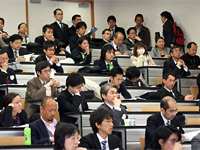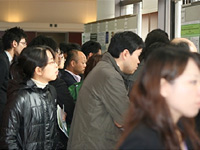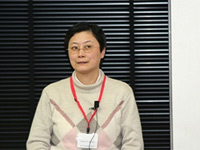Main host: Japan Science and Technology Agency, the Chemical Society of Japan
Venue: The 90th Spring Meeting of the Chemical Society of Japan held at the headquarters campus of Kinki University (Kowakae, Higashiosaka)
The relationship between global warming and carbon dioxide has recently been a hot topic of discussion. Full utilization of natural recyclable energy such as solar energy that does not depend on fossil resources has now become an urgent issue. The research area of the Sakigake (PRESTO) program of “Light Energy of Chemical Conversion” (Comprehensive research manager: Haruo Inoue, professor of the Tokyo Metropolitan University Center for Priority Areas) that first commenced in 2009 is now directly addressing the “light energy/chemical energy conversion (artificial photosynthesis)” which is one of the most essential issues in the effective use of sunlight.
Research on photosynthesis involves a variety of issues: (1) The development of material conversions in which the electron resource is water, (2) A method of realizing multi-electron conversions such as two-electron and four-electron conversions when using water as the electron resource, (3) Increasing the efficiency of the photo-reduction of carbon dioxide, (4) The development of a photo-catalytic metal complex that can oxidize water and reduce it to carbon dioxide, (5) The development of a highly efficient light collection system, (6) The realization of the electron transfer of photoelectrons from water to carbon dioxide, and (7) The overall system itself.
The international academic convention of the title was held for the purpose of discussing the situation with the latest research on and the future of "artificial photosynthesis" by inviting famous researchers at the cutting edge of the field from both home and overseas and making information on the importance of research on artificial photosynthesis available to young researchers in contributing to further progress being made in the PRESTO program "Light Energy of Chemical Conversion" at the 90th Spring Meeting of the Chemical Society of Japan, at which a great number of chemistry researchers gather.
International symposium (March 28), Number of participants: 517
Outline of the program was as follows:
1) Photo-oxygenation via two-electron conversion using water as the electron and oxygen resource: Toward artificial photosynthesis: Haruo Inoue (Professor of Tokyo Metropolitan University Center for Priority Areas and comprehensive manager of the research)
2) Charge storage in a molecular array: Anthony Harriman (Professor of Newcastle Univ., the U.S.A.)
3) Creation of a highly functional CO2 photo-reduction catalyst: Osamu Ishitani (Professor of the Tokyo Institute of Technology, the Graduate School of Science and Engineering)
4) Photochemical CO2 reduction using a transition metal complex: Current situation and future vision: Etsuko Fujita (Senior chemist of the Brookhaven National Laboratory, the U.S.A.)
5) Highly efficient molecular catalyst for water oxidization with visible light: Licheng Sun (Professor of the Royal Institute of Tech. (KTH), Sweden)
6) Molecular design and molecular assembly strategy for optical functional materials: V. W. W. Yam (Professor of Univ. of Hong Kong, Hong Kong)
7) Development of oxynitride photo-catalyst for the purpose of water decomposition: Kazunari Domen (Professor of the School of Engineering, the University of Tokyo)
8) Design of inorganic molecular materials for artificial photosynthesis system: Kazuhito Hashimoto (Professor of the School of Engineering, the University of Tokyo)
9) Development of innovative technology for use in next-generation organic solar batteries: Hiroshi Segawa (Professor of the Research Center for Advanced Science and Technology, the University of Tokyo)
10) Broad wavelength range solar energy conversion system using a light nano-antenna: Hiroaki Misawa (Professor of the Research Institute for Electronic Science, Hokkaido University)
Professor Harriman was the appointed researcher from overseas and has one of the most proven track records with research on artificial photosynthesis: This time his lecture mainly involved the latest results on the generation of hydrogen with light. Professor Sun is one of the research leaders whose research mainly involves the field of the generation of light hydrogen and who gave a lecture on the generation of oxygen from water, which is currently being focused upon. Professor Yam is a world famous researcher on the fundamental photochemical behavior of metal complexes and who reported the latest results of research on the optical functions of metal complexes. Dr. Etsuko Fujita (senior chemist) is an authority on the photo-reduction of carbon dioxide and who has been involved in pioneering research on carbon dioxide reduction using metal complexes, the reaction mechanism in particular. This time she gave a lecture on the theme of the current situation, issues involved, and future vision of carbon dioxide reduction. All six appointed researchers from Japan have also achieved excellent evaluations for their results of research at the global level and introduced the latest results of their research and future vision as global authorities on the topic. As many as 517 participated, including those of the Spring Meeting of the Chemical Society of Japan, and it ended up being oversubscribed: Many questions were asked, with active discussions then taking place at each lecture.
The 13 researchers employed within the 2009 PRESTO program of “Light Energy of Chemical Conversion” presented the results of their research in English at a poster session in the lobby on the site, which also proved very popular, and with lively discussions also taking place there.
Moreover, in the international symposium Osamu Ichimaru, the counselor general of JST, as the main host introduced the program and strategic goals, while Ryoji Haraguchi, the assistant to the director, made a public offering of the PRESTO program.
Post meeting (March 29), Number of participants: 40
At the post meeting that was held a day after the international symposium the PRESTO program researchers presented the condition, results, and future vision of their research in English. Appointed researchers from overseas and the PRESTO program advisors encouraged and provided valuable advice to the PRESTO program researchers and held a wide range of discussions. It proved to be an excellent opportunity for the PRESTO program researchers to present the results of their research at an international level, with the experience presumably having been incredibly valuable to them.
The symposium and post meeting involved many top researchers who are promoting pioneering research on artificial photosynthesis at both home and overseas: They presented the respective results of their research and future vision in sharing the current situation with the issue, thus enabling concentrated active discussions to take place on the direction needing to be taken in settling them. It surely must have been an excellent opportunity to obtain extremely beneficial advice and information on the research theme for the researchers from the PRESTO program as well as the other participants. This international symposium drew over 500 participants, consisting of researchers from universities and companies, far beyond our expectations, and thereby revealing the high level of interest in the field of artificial photosynthesis. We hope that the success of the event will contribute to more participation in this particular area of research and the further activation of related research through providing the chance for information on the current situation with and importance of artificial photosynthesis to be disseminated, and therefore would appreciate any opinions and requests being made to the following.
Contact address
Hiroshi Tamaki, Technical counselor
“Chemical Conversion of Light Energy” Research Area Office, Japan Science and Technology Agency
Project Research Bldg. 302, Tokyo Metropolitan University
1-1 Minamiosawa, Hachioji Tokyo JAPAN 192-0397
TEL: +81-42-653-3415 FAX: +81-42-653-3416
E-mail: tamaki![]() chem-conv.jst.go.jp
chem-conv.jst.go.jp



JST, an integrated organization of science and technology in Japan, establishes an infrastructure for the entire process from the creation of knowledge to the return to the society. For more information, visit http://www.jst.go.jp/EN/